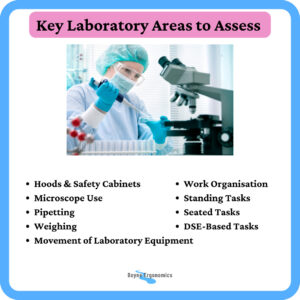Laboratory work is an essential part of scientific research and the pharmaceutical industry. Laboratory based roles can often involve high levels of static postures, repetitive movements, adverse postures, high focus tasks, fine precision movements, manual handling and working with chemicals.

The occurrences of musculoskeletal disorders among laboratory based employees are well documented.
In a cross sectional survey examining musculoskeletal discomfort among medical science students, Penkala et al (2018) reported that over a third reported musculoskeletal discomfort during training in the previous 12 months, with a quarter reporting musculoskeletal discomfort in the last 7 days. What is astonishing about this finding is that these students were only spending one sixth of their time in the laboratory compared to full time laboratory based employees! The areas of discomfort reported were the hands , shoulders, lower back and neck.
This was echoed more recently in the findings of Nalunga et al (2023) who found that 48.3% of laboratory based employees reported one or more instances of work related musculoskeletal discomfort in the last 12 months.
To ensure the well-being of laboratory based employees, it is crucial to promote safe ergonomic practices when completing laboratory based tasks.
In this blog post, I will explore key areas of concern and provide practical advice to reduce the risk of musculoskeletal discomfort, fatigue and stress at the different common laboratory work areas.
These areas are work organisation, standing tasks, seated tasks, DSE based tasks, working at hoods and safety cabinets, working with microscopes, pipetting and manual handling / use of equipment.

Work Organization
Proper work organisation is fundamental to maintaining ergonomic safety in the laboratory. Here are some tips for optimizing your laboratory work environment:
- Prioritize task organization: Plan work and schedule tasks in a way that allows for breaks and avoids excessive repetition. Avoid rotating employees from a task to another with similar characteristics and risks, e.g. from one repetitive task to another.
- Maintain a tidy workspace: Keep your lab bench clear of clutter to prevent accidental spills and reduce unnecessary movements. Ensure the lab area and floor is free of obstructions, trip hazards and spills.
- Arrange frequently used equipment, tools, and supplies within arm’s reach to reduce unnecessary stretching and twisting.
- Use labels and color coding: Properly label chemicals and materials to minimize confusion and reduce the time spent searching for items.
Standing Laboratory Tasks
For tasks that require standing for extended periods, consider the following ergonomic tips:
- Anti-fatigue mats: These mats provide cushioning to reduce the stress on the legs and lower back and should be provided in areas where tasks are performed in the standing position.
- Adjustable lab benches: Ensure that work surfaces can be adjusted to the appropriate height for each task and each user. In some laboratories, there are multi-use areas used by different employees at various times. By providing a height adjustable work surface, you allow for the work area to be adjusted as required to reduce adverse postures.
- Change position: Alternate between standing, sitting and perching to reduce the strain on lower back and legs when completing tasks.
- Take regular microbreaks: Stand up, stretch, and walk around at regular intervals to relieve tension and improve blood circulation.
Seated Laboratory Work
Seated laboratory work can also be physically demanding. To maintain ergonomic safety while sitting, consider the following:
- Choose an adjustable ergonomic chair: Whether for a fixed height seated, fixed height standing or adjustable work surface, the chair should be height adjustable, with adequate adjustable lumbar support and comfortable padding.
- Adjust the chair and workbench height: Before you start the task, ensure that the chair and workbench are at the correct height to maintain proper alignment of your arms and legs.
- Ensure footrests are available that are appropriate for the height of the work surface. This is applicable to seated, standing and adjustable work surfaces to ensure there is adequate support for all users.
- Take regular microbreaks: Stand up, stretch, and walk around at regular intervals to relieve tension and improve blood circulation.
DSE-Based Tasks
Many laboratory tasks involve working on a computer. Here’s how to maintain ergonomic safety for DSE-based tasks:
- Ensure there is an appropriate work surface and adjustable seating available at the DSE workstation.
- Ensure there is an external keyboard, mouse and monitor available at the DSE workstation.
- Use an adjustable monitor stand: Position the computer screen at eye level to avoid neck strain.
- Maintain appropriate posture: Sit back in the chair with your feet flat on the floor / footrest, elbows level with the work surface when shoulders are relaxed and ensure the screen is in your eye line when looking ahead.
- Take regular microbreaks: Stand up, stretch, and walk around at regular intervals to relieve tension and improve blood circulation.
Working at Hoods, Isolators and Safety Cabinets
When working in hoods, isolators or safety cabinets, it’s important to consider these ergonomic guidelines:
- Ensure that the hood or safety cabinet is at a comfortable height to avoid unnecessary strain when conducting tasks inside. Use adjustable stands if needed.
- Adjust the hood or cabinet’s sash: Position it at an appropriate height to minimize strain on the arms and neck.
- Use a footrest: Elevating the feet can relieve pressure on the lower back when working inside a hood.
- Proper Ventilation: Maintain a comfortable working environment by ensuring adequate ventilation, as poor air quality can lead to discomfort and health issues.
- Ensure that the PPE provided is appropriate for the task and the user. Poor fitting PPE, especially gloves can increase adverse postures, repetition and forces required when completing tasks in these environments.
- Limit time spent inside the hood: Minimize prolonged exposure by planning and organizing tasks efficiently.
Working with Microscopes
Proper microscope use is critical for laboratory safety. Follow these recommendations:
- Maintain an upright posture: Back straight and head aligned with the microscope’s eyepiece.
- Use an adjustable microscope stand: Ensure the microscope is at a comfortable height and angle.
- Proper Lighting: Ensure that the microscope is well-lit to reduce eye strain. Avoid glare on the lenses and use task lighting when necessary.
- Take regular breaks: Rest the eyes and neck by looking away from the microscope periodically.
Pipetting
Pipetting is a common task in the laboratory. To reduce the risk of strain and errors, consider these tips:
- Use an ergonomic pipette: Choose a pipette with an ergonomic design, including adjustable plunger force and comfortable grips, to reduce the strain on the hands and wrists.
- Practice proper pipetting technique: Use the right finger positions and apply minimal force when pipetting.
- Alternate hands: When possible, switch between the dominant and non-dominant hand to reduce muscle fatigue.
- Avoid Overreaching: Position the pipettes and samples within easy reach. Overreaching can lead to discomfort and potential injury over time.
- Regularly calibrate your pipettes to maintain accuracy and ease of use.
Manual Handling and Laboratory Equipment
Handling laboratory equipment, including balances and centrifuges, requires careful attention to ergonomics:
- Keep equipment at waist level: Position the equipment at a comfortable working height to avoid awkward postures.
- Use carts and trolleys: When moving heavy equipment, use mobile carts to reduce the risk of strain or injury.
- Seek help when necessary: Request assistance when dealing with heavy equipment.
- Practice appropriate manual handling technique: When lifting, bend the knees and keep the load close to the body. Avoid twisting the spine while lifting heavy objects. Point the feet in the direction of travel and the load destination before placement.
By paying attention to work organization, adjusting workstations, and following ergonomic guidelines, the risk of musculoskeletal injuries and discomfort, fatigue and stress will be reduced, ensuring the health, wellbeing and productivity of laboratory based employees.
Sources:
Nanluga et al (2023) Work Related Musculoskeletal Disorders Among Staff at Selected Laboratories in Kampala. Research Square
https://www.researchsquare.com/article/rs-2695804/v1
Penkala et al (2018) Work-related musculoskeletal problems related to laboratory training in university medical science students: a cross sectional survey. BMC Public Health


